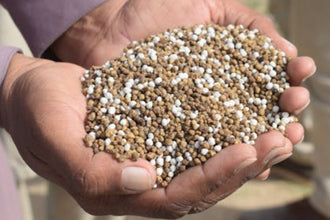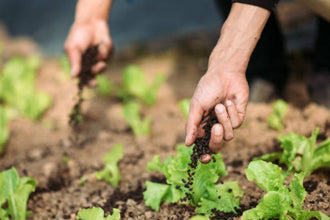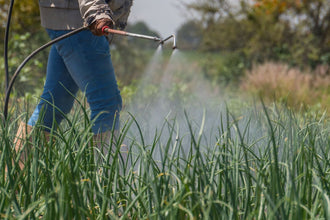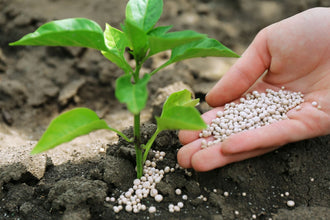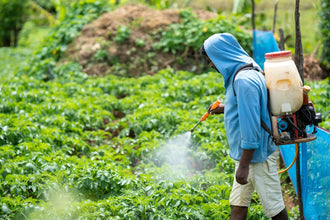
Fertilizer burn happens when you give your plants too much food at once. You know that sinking feeling when your green grass suddenly turns brown or your vegetable plants look like they've been hit by fire. This problem hits gardeners everywhere, but don't worry. You can fix it and prevent it from happening again.
Plants get fertilizer burn when there's too much salt in the soil around their roots. These salts actually pull water away from your plants instead of feeding them. So even when you water regularly, your plants end up thirsty and stressed out.
What Really Causes Fertilizer Burn
Most gardeners run into this problem at some point. Usually, it comes down to a few common mistakes that are easy to avoid once you know what to look for.
The Too Much Problem
Lots of people think more fertilizer means better plants. This backfires pretty quickly. Plants can only eat so much at one time, kind of like how you'd feel sick if you ate three dinners in a row.
Chemical fertilizers pack a lot of concentrated salts. When you use too much, these salts build up in your soil. Your plant roots can't handle all that salt, so they stop taking up water properly. The plant ends up looking drought stressed even when you're watering it every day.
Timing matters too. Putting fertilizer down during hot, dry weather makes everything worse. The heat speeds up chemical reactions and makes the salt problem more severe. Your plants are already working hard to stay cool, and then you hit them with a salt overload.
Weather Makes It Worse
Hot, sunny days are the worst time for fertilizer burn to show up. The sun makes everything happen faster, and dry air sucks moisture right out of plant leaves. Your poor plants don't stand a chance.
Bad watering habits make this problem even worse. If you put fertilizer on dry soil and don't water it in well, all those salts get concentrated right where the roots are trying to grow. Light sprinkles don't help either because they keep the salts sitting right at the surface.
Windy spots create extra problems because plants lose water faster through their leaves. These plants are already working overtime to stay hydrated, so they can't handle fertilizer stress as well.
How to Spot Fertilizer Burn
Catching this problem early can save your plants. Different plants show different symptoms, but there are some warning signs that show up pretty consistently.
What You'll See Above Ground
Yellow leaves usually show up first, especially around the edges and tips. This happens because that's where salt concentrations get the highest. After the yellowing comes brown, crispy edges that look like someone held a lighter to them.
Plants start dropping leaves next. Even leaves that look okay might fall off suddenly when the salt stress gets bad enough. New growth slows down or stops completely because the plant is too busy trying to survive.
In really bad cases, you'll see stem damage too. Young shoots might wilt or turn black at the tips. On trees and shrubs, the bark might crack or peel off.
Root Problems You Can't See
The real damage happens underground where you can't see it. Salt buildup burns those tiny feeder roots that do most of the work absorbing water and nutrients. These little roots turn brown and mushy, and they can't do their job anymore.
Healthy roots look white or cream colored and feel firm. Damaged roots turn dark, smell bad, and feel slimy. Sometimes bacteria move in and make the problem even worse.
You might see a white, crusty layer on top of the soil around your plants. This crust means you've got serious salt buildup that needs immediate attention.
How to Prevent Fertilizer Burn
Smart fertilizer use prevents most burn problems. These tips work whether you're just starting out or you've been gardening for years.
Do It Right the First Time
Always read the label on your fertilizer and follow the directions exactly. Companies spend a lot of time and money figuring out the right amounts, so trust their research instead of guessing.
Pick the right time to fertilize. Cool, cloudy days work best. Early morning or late evening applications are good too because temperatures stay reasonable and humidity is higher.
Water your plants well before you fertilize, then water again afterward. The first watering makes sure the soil isn't bone dry. The second watering dilutes the fertilizer and moves it down to where roots can use it safely.

If you're using granular fertilizer, spread it evenly. Hot spots with too much fertilizer will burn your plants for sure. A spreader helps you get even coverage on big areas like lawns.
Test Your Soil First
Getting your soil tested before you fertilize prevents a lot of problems. The test tells you what nutrients are already there, what your pH is, and whether you have salt buildup issues.
Most soils need testing every few years. Problem soils might need annual testing until things improve. You can get basic test kits at garden centers, but lab tests give you more detailed information.
pH affects how well plants can use fertilizer. Soil that's too acidic or too basic prevents plants from absorbing nutrients properly. This makes people apply more fertilizer trying to fix the problem, which usually makes things worse.
Soil with lots of organic matter handles fertilizer better than sandy or heavy clay soil. Adding compost before you fertilize reduces burn risk and improves your soil overall.
Fixing Plants with Fertilizer Burn
Quick action can save plants that are showing burn symptoms. What you do depends on how bad the damage is and what kind of plants you're dealing with.
What to Do Right Away
The first step is flushing all that salt out of the soil with lots of water. Water slowly and deeply so you can push the salts down below where the roots are growing. You might need to do this several times over a few days.
Cut off the really damaged parts of your plants. Use clean pruning shears so you don't spread diseases around. Get rid of the brown, crispy stuff but leave anything that still looks healthy.
Stop fertilizing completely until your plants recover. They need time to get over the salt stress before you give them any more food. Wait until you see healthy new growth before you even think about fertilizing again.
Give your recovering plants some shade if you can. Old sheets or shade cloth work fine. This reduces stress while they're trying to heal. You can gradually move them back to full sun as they get better.
Helping Plants Recover Long Term
Recovery takes time, so be patient. Most plants start looking better in a few weeks if you catch the problem early. Really bad cases might take months to fully recover.
Add organic matter around your hurt plants. Compost, aged manure, or leaf mold help protect against future salt problems. They also feed the good bacteria and fungi in your soil that help plants handle stress.
Keep an eye on soil moisture during recovery. Consistent moisture helps plants bounce back from salt stress, but don't overwater because that can cause root rot. Stick your finger down into the soil about two inches to check moisture levels.
Consider switching to organic fertilizers for your next applications. Organic fertilizers release nutrients slowly and almost never cause fertilizer burn. They also support the living things in your soil that help plants stay healthy.
Choosing Better Fertilizer
The type of fertilizer you pick makes a big difference in burn risk. Different formulas behave differently in soil, and some are much safer than others.
Slow Release Options
Slow release fertilizers give your plants steady nutrition without overwhelming them. These products coat the nutrients with materials that break down gradually over several months. This prevents those sudden salt spikes that cause fertilizer burn.
Some slow release fertilizers respond to soil temperature and moisture. They release more food when plants are growing actively and less when they're resting. This natural timing reduces waste and prevents over fertilization.
Organic fertilizers work as natural slow release options. Things like composted chicken manure break down slowly, feeding the soil creatures that make nutrients available to plants. This biological process prevents sudden increases in salt levels.
When to Apply Fertilizer
Spring fertilizing needs extra care because plants are just waking up from winter. Their root systems might not be fully active yet, making them more sensitive to salt. Start light and increase gradually as growth picks up.
Fall fertilizing works well because it helps plants get ready for winter without the risk of summer burn. Cooler temperatures and higher humidity make fertilizer burn less likely. Plants can store up nutrients for early spring growth without getting stressed.
Don't fertilize during droughts or heat waves. Stressed plants can't handle extra salt very well. Wait for better weather before you get back to your normal fertilizer routine.
Building Soil That Prevents Problems
Healthy soil prevents most fertilizer problems while helping your plants grow better. Focus on improving your soil instead of just dumping more fertilizer on struggling plants.
Good soil acts like a buffer against fertilizer burn. It holds the right amount of moisture, provides steady nutrition, and supports all the tiny creatures that help plants stay healthy. When you build good soil, you need less fertilizer overall.
Why Organic Matter Helps
Compost works like insurance against fertilizer burn. It holds moisture, provides slow release nutrients, and feeds beneficial soil creatures. Regular compost additions create growing conditions that can handle fertilizer applications much better.
Mulch around your plants helps keep soil moisture and temperature steady. Organic mulches slowly break down and add nutrients and organic matter to your soil. This natural process means you don't need to fertilize as often.
Cover crops improve soil in vegetable gardens and flower beds. These plants add organic matter, stop erosion, and support soil biology. When your soil biology is healthy, plants can access nutrients more efficiently and you need less fertilizer.
Why Organic Fertilizer Prevents Burn Better Than Chemicals
Fancy Chicken Makes Safe Feeding Simple
Chemical fertilizers pack way too much salt into every application. One wrong measurement and you're dealing with crispy brown leaves. Fancy Chicken organic pelletized chicken manure works completely differently.
The 4-2.5-2 NPK ratio gives your plants exactly what they need without overwhelming them. These pellets break down slowly in your soil, releasing nutrients gradually over weeks instead of all at once. Your plants get steady nutrition while those beneficial soil microbes get to work breaking everything down naturally.
Salt buildup becomes almost impossible with organic chicken manure. The organic matter in Fancy Chicken pellets actually helps flush excess salts from previous chemical applications. So you're fixing old problems while feeding your current plants.
Protection That Builds Over Time
Each application of Fancy Chicken does more than just feed your plants. The organic matter improves your soil structure, helping it hold the right amount of moisture. This balanced moisture level means nutrients move through the soil properly instead of concentrating in dangerous hot spots.
Your soil biology gets stronger too. All those good bacteria and fungi multiply when you feed them organic matter. These tiny helpers break down nutrients into forms your plants can actually use. They also produce compounds that protect roots from stress and disease.
Key benefits for preventing fertilizer burn:
-
Slow nutrient release prevents salt concentration spikes
-
Organic matter buffers against sudden pH changes
-
Improved soil structure helps water move nutrients evenly
-
Enhanced microbial activity breaks down salts naturally
-
Gentle formula works safely in hot weather
-
No harsh chemicals to damage sensitive roots
Application Tips for Zero Burn Risk
Getting started with Fancy Chicken pellets couldn't be easier. Spread them around your plants every 4 to 6 weeks during the growing season. The pellets won't burn even if they touch leaves or stems directly, which gives you peace of mind during application.
Water after spreading, but you don't need to drench everything like you would with chemical fertilizers. A normal watering is enough to start the breakdown process. The pellets will continue releasing nutrients through your regular watering schedule.
You can apply Fancy Chicken any time during the growing season without worrying about weather conditions. Hot days, cool days, dry spells, or humid stretches all work fine. This flexibility makes garden care so much simpler than trying to time applications around perfect weather windows.
Plants recovering from fertilizer burn respond especially well to organic chicken manure. The gentle nutrition helps them rebuild damaged roots without adding more stress. You'll see new growth within a few weeks as your plants get back to full health.
Start Feeding Your Garden the Right Way
Your plants deserve better than the feast-or-famine cycle of chemical fertilizers. Fancy Chicken organic pelletized chicken manure gives them consistent nutrition that builds soil health with every application. No more brown tips, no more salt crust, no more watching your garden struggle after you tried to help it. Make the switch to organic feeding that actually works with nature instead of against it.




